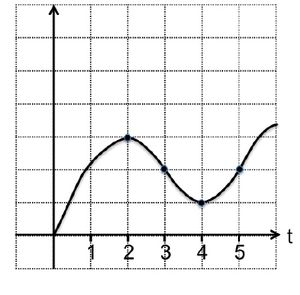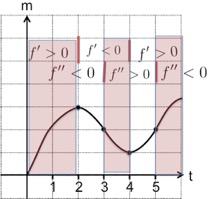Science:Math Exam Resources/Courses/MATH104/December 2016/Question 02 (b)
{{#incat:MER QGQ flag|{{#incat:MER QGH flag|{{#incat:MER QGS flag|}}}}}}
• Q1 (a) • Q1 (b) • Q2 (a) • Q2 (b) • Q3 (a) • Q3 (b) • Q4 (a) • Q4 (b) • Q5 (a) • Q5 (b) • Q6 (a) • Q6 (b) • Q7 (a) • Q7 (b) • Q8 (a) • Q8 (b) • Q9 (a) • Q9 (b) • Q9 (c) • Q10 • Q11 (a) • Q11 (b) • Q11 (c) • Q11 (d) • Q12 • Q13 •
Question 02 (b) |
|---|
|
The graph of the position of a particle is shown below, where is measured in second and the dots are local extrema or points of inflection. Determine when the particle is speeding up. Hint: a particle is "speeding up" when its velocity and acceleration have the same sign. |
|
Make sure you understand the problem fully: What is the question asking you to do? Are there specific conditions or constraints that you should take note of? How will you know if your answer is correct from your work only? Can you rephrase the question in your own words in a way that makes sense to you? |
|
If you are stuck, check the hint below. Consider it for a while. Does it give you a new idea on how to approach the problem? If so, try it! |
Hint |
|---|
|
Followed the hint from question, the velocity is , and the acceleration is the derivative of velocity . Find the sign of |
|
Checking a solution serves two purposes: helping you if, after having used the hint, you still are stuck on the problem; or if you have solved the problem and would like to check your work.
|
Solution |
|---|
|
The first derivative of m is straightforward, if the derivative is positive, then . For , we use the points of inflection (3 and 5 from question). 3 is one inflection point. From 0 to 3, goes from positive to negative, thus during that area, . For . For . The part where are both positive: The part where are both negative: answer: |
{{#incat:MER CT flag||
}}








![{\displaystyle t\in [3,5],f''>0}](https://wiki.ubc.ca/api/rest_v1/media/math/render/svg/5bee784f2958d3e453d8ffb143a0ca76ba99cf7b)




